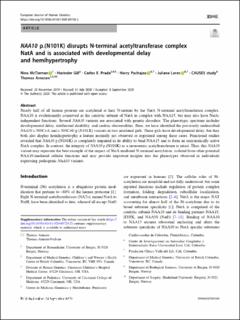| dc.contributor.author | Mc Tiernan, Nina | |
| dc.contributor.author | Gill, Harinder | |
| dc.contributor.author | Prada, Carlos E. | |
| dc.contributor.author | Pachajoa, Harry | |
| dc.contributor.author | Lores, Juliana | |
| dc.contributor.author | Arnesen, Thomas | |
| dc.date.accessioned | 2021-04-06T17:41:22Z | |
| dc.date.available | 2021-04-06T17:41:22Z | |
| dc.date.created | 2020-10-01T11:23:42Z | |
| dc.date.issued | 2020 | |
| dc.Published | European Journal of Human Genetics. 2020, 1-9. | |
| dc.identifier.issn | 1018-4813 | |
| dc.identifier.uri | https://hdl.handle.net/11250/2736446 | |
| dc.description.abstract | Nearly half of all human proteins are acetylated at their N-termini by the NatA N-terminal acetyltransferase complex. NAA10 is evolutionarily conserved as the catalytic subunit of NatA in complex with NAA15, but may also have NatA-independent functions. Several NAA10 variants are associated with genetic disorders. The phenotypic spectrum includes developmental delay, intellectual disability, and cardiac abnormalities. Here, we have identified the previously undescribed NAA10 c.303C>A and c.303C>G p.(N101K) variants in two unrelated girls. These girls have developmental delay, but they both also display hemihypertrophy a feature normally not observed or registered among these cases. Functional studies revealed that NAA10 p.(N101K) is completely impaired in its ability to bind NAA15 and to form an enzymatically active NatA complex. In contrast, the integrity of NAA10 p.(N101K) as a monomeric acetyltransferase is intact. Thus, this NAA10 variant may represent the best example of the impact of NatA mediated N-terminal acetylation, isolated from other potential NAA10-mediated cellular functions and may provide important insights into the phenotypes observed in individuals expressing pathogenic NAA10 variants. | en_US |
| dc.language.iso | eng | en_US |
| dc.publisher | Springer | en_US |
| dc.rights | Navngivelse 4.0 Internasjonal | * |
| dc.rights.uri | http://creativecommons.org/licenses/by/4.0/deed.no | * |
| dc.title | NAA10 p.(N101K) disrupts N-terminal acetyltransferase complex NatA and is associated with developmental delay and hemihypertrophy | en_US |
| dc.type | Journal article | en_US |
| dc.type | Peer reviewed | en_US |
| dc.description.version | publishedVersion | en_US |
| dc.rights.holder | Copyright 2020 The Author(s). | en_US |
| cristin.ispublished | true | |
| cristin.fulltext | original | |
| cristin.qualitycode | 1 | |
| dc.identifier.doi | 10.1038/s41431-020-00728-2 | |
| dc.identifier.cristin | 1836072 | |
| dc.source.journal | European Journal of Human Genetics | en_US |
| dc.source.pagenumber | 280–288 | en_US |
| dc.identifier.citation | European Journal of Human Genetics. 2021, 29, 280–288 | en_US |
| dc.source.volume | 29 | en_US |

